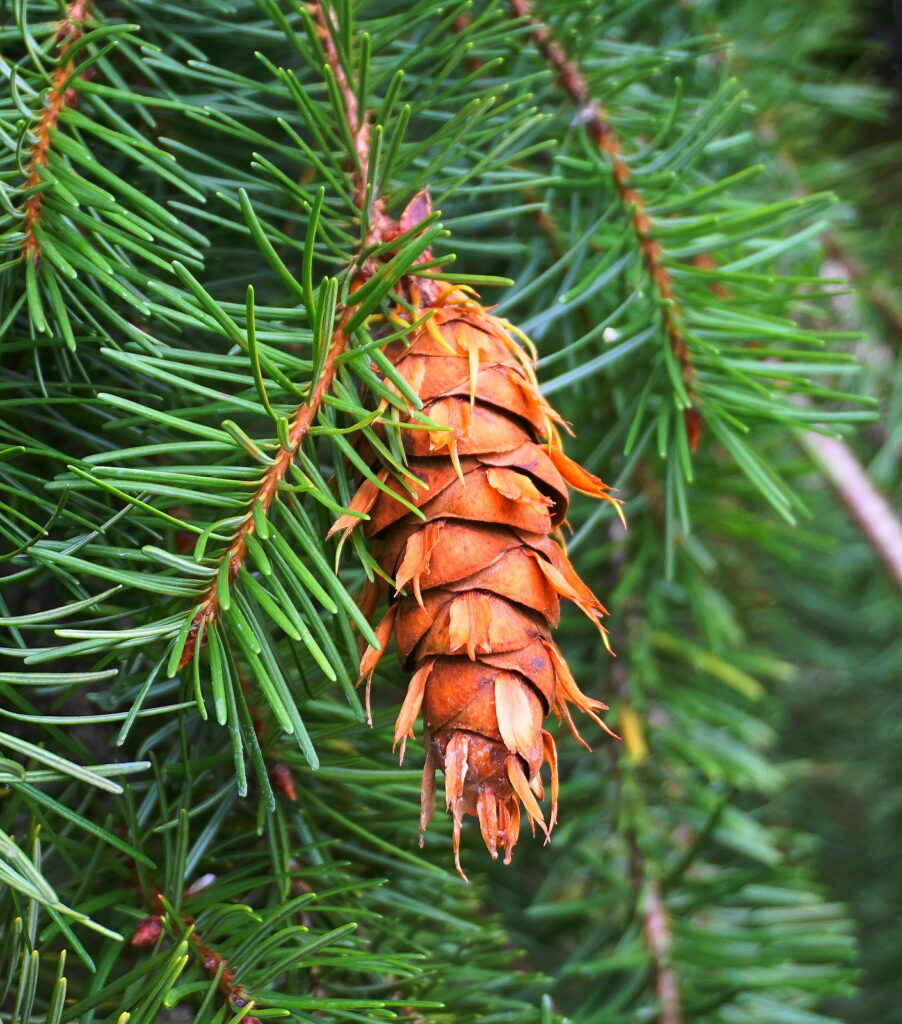Pseudotsuga–commonly called Douglas fir–are cone-shaped members of the pine tree family. They can grow 70 to 200 feet tall and 80 feet wide; they are perhaps best known as cut Christmas trees.
Pseudotsuga has soft, densely set, green or blue-green needles to 1.5 inches long that radiate in all directions from the branches. The needles are sweetly fragrant when crushed. The end of branches swing up.
Pseudotsuga are evergreen coniferous trees native to forests in North America, Mexico, China, and Japan. They are imposing specimen trees that demand large spaces.

Get to know Pseudotsuga
- Plant type: Evergreen tree
- Growing zones and range: Zones 4 to 7
- Hardiness: Hardy to Zone 4
- Height and width: 70-200 feet (21.3-61m) tall and 80 feet (24.4m) wide in forests
- Growth rate: Fast
- Form and habit: Cone shaped
- Foliage: Soft, densely set, green or blue-green needles up to 1.5 inch (3.8cm) long radiate in all directions from the branches; needles are sweetly fragrant when crushed; ends of branches swing up
- Flowers: Pointed wine red buds form at branch tips in winter
- Fruits: Reddish brown, oval cones are about 3 inches (7.6cm) long, have obvious three-pronged bracts; cones hang down; female cones have protruding, trident-shaped bract scales; males are cyllindrical
- Uses: Christmas trees, landscape, hedge, or as specimen trees
- Garden companions:
- Common name: Douglas fir
- Botanical name: Pseudotsuga
- Family name: Pinaceae
- Origin: Alaska through Northern California, eastward into the Rocky Mountains, and southward into northern Mexico
Where to plant Pseudotsuga
- Plant Pseudotsuga in full sun; takes part shade in youth.
- Plant Pseudotsuga in moist, well-drained, deep, acid to neutral soil; blue types tolerate slightly alkaline soil.
- Pseudotsuga are sensitive to road salt.
When to plant Pseudotsuga
- Sow seed in containers outdoors in spring.
- Transplant balled-and-burlapped Pseudotsuga in fall and spring.

Planting and spacing Pseudotsuga
- Do not plant Pseudotsuga within 200 feet (61m) of Colorado Spruce (Picea pungens), as they alternate hosts for Cooley spruce gall aphids.
- Plant Pseudotsuga 15-25 feet (5-8m) apart
How to water and feed Pseudotsuga
- Give Pseudotsuga regular to little water.
- Feed Pseudotsuga with an all-purpose organic fertilizer in spring
How to care for Pseudotsuga
- Pseudotsuga rarely needs pruning.
- Allow Pseudotsuga branches to remain to the ground.
- Pseudotsuga branches may break if laden with snow or ice; shear new growth annually for a hedge.
Pseudotsuga pests and diseases
- Pseudotsuga are susceptible to attacks by caterpillars, aphids, scale insects, bark beetles, budworms, gypsy moths, tussock moths and root weevils.
- Canker, dieback, brown felt blight, root rot, lesion nematode, needle cast, twig light, and scale can be a problem too.
- Mulch with organic matter to keep soil most; vigorous, well-nourished plants have a natural ability to resist pests and diseases.
Pseudotsuga propagation
- Graft cultivars in late winter.
Pseudotsuga varieties to grow
- Pseudotsuga menziesii, Douglas fir, in the wild, this is one of the tallest trees in North America, reaching 200 feet (61m) in height. In home landscapes, it usually grows into a spirelike, 50-80 foot (15.2-24.4m) tall, 15-25 foot (5-8m) wide pyramid. The branches are mostly horizontal—downswept at the bottom and upturned near the top of the single main trunk. The fine-textured, 1-1.5 inch (2.5-3.8cm) long needles are arranged spirally in two ranks around the twigs.















